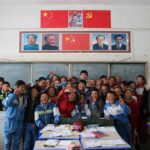
“Huangshi possesses both industrial strength and natural beauty,” On August 18, the national online media chief editors’ research tour and online theme promotion activity titled “Huangshi, A Place That Turns Stone into Gold” officially commenced, marking the 75th anniversary of Huangshi’s establishment as a city. Chief editors from 29 online news media outlets across the country visited the Huangshi Planning Exhibition Hall to learn about the city’s history, culture, development achievements, and future blueprint.
Huangshi is rich in mineral resources and has long been known as the “Hundred Miles of Golden Land, the Treasure Basin of the South.” “Melting the old to cast the new, turning stone into gold” has been Huangshi’s most distinctive trait and unique cultural thread for thousands of years. The chief editors felt at the Huangshi Planning Exhibition Hall that this characteristic shines brightly in Huangshi today.

This is the “Cradle of Modern National Industry,” where every inch of land is infused with industrial genes
3,500 years ago, the ancestors of the Chu State discovered the earliest ancient copper mine in Chinese history in Huangshi. Through mining, smelting, and advanced metallurgical techniques, Huangshi became one of the birthplaces of China’s bronze culture, leaving behind the Tonglüshan Ancient Copper Mine Site, the earliest of its kind in China and rare in the world.
The exhibition hall docent explained that in 1889, Zhang Zhidong, the Governor of Huguang, established China’s first large-scale open-pit iron mine here—the Daye Iron Mine. In 1908, Sheng Xuanhuai merged the Daye Iron Mine, the Hanyang Ironworks, and the Pingxiang Coal Mine to create the Hanyeping Coal and Iron Company, the largest and earliest steel conglomerate in Asia at the time. “Not only that, but the first cement plant in the Far East, the largest power plant in Central-South China, and the largest coal base in Hubei Province were all born in Huangshi,” the docent added.
“These ‘firsts’ are not only Huangshi’s pride but also symbols of the rise of modern Chinese industry. No wonder Huangshi is called the cradle of modern national industry—every inch of this land is infused with industrial genes,” one attendee remarked.
This is a place “worth seeing even if you have to ride a donkey,” solidifying New China’s “industrial granary”
In 1950, Huangshi was officially established as a city and became a key industrial and mining zone during China’s First Five-Year Plan. Twenty-seven key industrial projects, including the Daye Steel Plant, Huaxin Cement Plant, and Daye Nonferrous Metals Company, rose from the ground in Huangshi. In 1953 and 1958, Mao Zedong inspected Huangshi twice, calling it a place “worth seeing even if you have to ride a donkey.”
According to statistics, from its establishment as a city until 2008, Huangshi contributed 190 million tons of iron ore, 54 million tons of raw coal, 560 million tons of non-metallic minerals, 28.65 million tons of steel, 2.7 million tons of copper, and 500 million tons of cement to the nation.
When the docent mentioned the well-known song “Little Swallow,” one participant felt deeply moved. “‘Little Swallow’ sings not only of spring but also of the fiery passion of Huangshi’s builders. Key industrial projects rose one after another here, and Huangshi solidified New China’s ‘industrial granary’ with an iron will. Mao Zedong’s description of it as a place ‘worth seeing even if you have to ride a donkey’ is truly deserved,” they said.

This once steel-sparking city is now radiating a new era of green and intelligent development
<p



